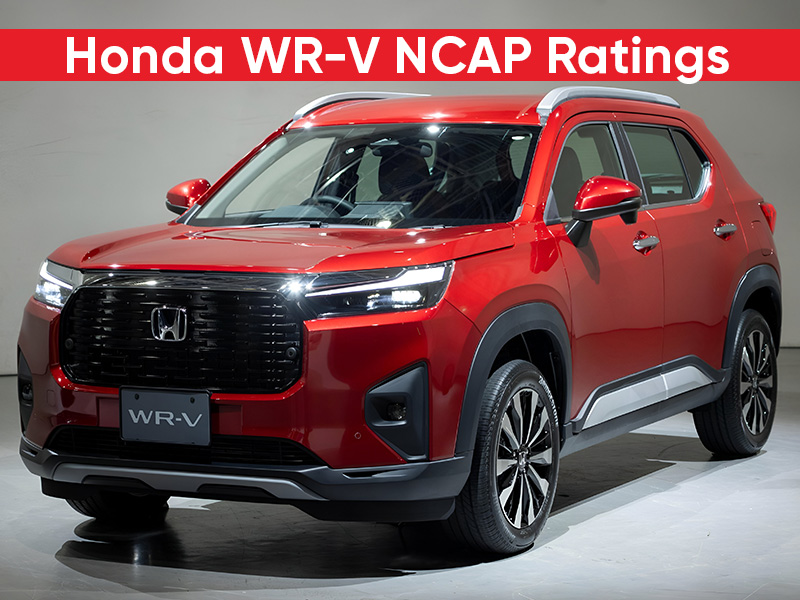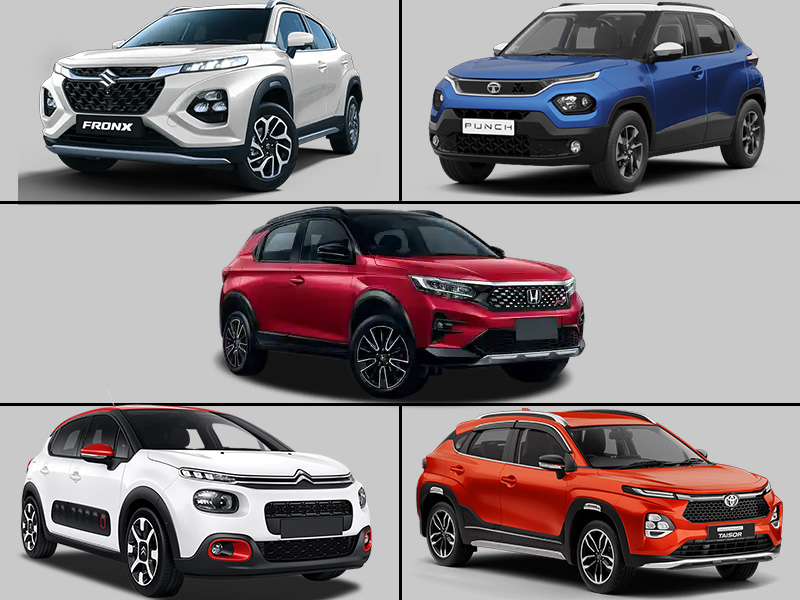The Honda WR-V brings together style, efficiency, and everyday practicality—earning favour among urban and semi-urban drivers in India and overseas. But as the car market evolves, looks and performance no longer suffice—safety now stands at the forefront of every buying decision. How safe is the car? How does it perform during a crash? What features help prevent accidents? That’s where car safety ratings come in. These ratings are decided by global safety agencies after putting cars through tough crash tests and evaluations. Let’s understand what these ratings really mean and how the Honda WR-V safety rating was determined, and how it performs across the board.
What Is a Safety Rating?
A safety rating is an independent, standardised way to measure how well a vehicle protects people inside and outside during a crash, and how well it avoids one in the first place through modern tech. These ratings are given by global safety bodies after detailed crash tests and system checks.

- ASEAN NCAP tests cars in Southeast Asia—India, Malaysia, Indonesia—looking at adult and child safety, but also motorcyclist protection, because two-wheelers are everywhere here, and their goal is to improve safety standards in emerging markets fast.
- Latin NCAP works across Latin America, pushing for better regulations because many cars there come with minimal safety features, so they focus hard on essentials like airbags, ESC, and child protection systems that are often skipped in base models.
- Global NCAP is a UK-based group that supports safety testing in developing markets—it didn’t test every car itself, but backed programs like Safer Cars for India, which raised awareness and pushed Indian automakers to take safety more seriously.
- JNCAP, run by Japan’s government, is one of the most detailed testing programs—it covers crash safety, autonomous braking, lane-keeping, even how quickly the car alerts emergency services after a crash, all measured in one of the world’s most tech-driven car markets.
Know a little more about NCAPs – Bharat NCAP vs Global NCAP: Decoding Car Safety Standards!
Types of Safety Tests They Conduct
All NCAP agencies follow scientific, controlled crash tests and system evaluations. Here are the key ones:
- Frontal Crash Test – Simulates a head-on collision. A car is driven into a fixed barrier at around 64 km/h with crash test dummies inside. This shows how well the front of the car absorbs impact and protects passengers.
- Side Impact Test – Simulates a crash where another vehicle hits the side of your car—very common at intersections. It checks side airbags, door strength, and how well passengers are shielded from intrusion.
- Pedestrian Safety Test – Evaluates how well the car’s bonnet, bumper, and windshield area reduce injury risk to pedestrians in case of an accident. This is critical in urban areas with heavy foot traffic.
- Child Safety and Restraint System Checks – Examines how well child car seats perform using ISOFIX mounts and how the vehicle accommodates child occupants in the event of a crash. Also checks for airbag deactivation switches and warning labels.
Why Honda WR-V Safety Rating Matters?
Safety ratings aren’t just stars on paper—they’re real indicators of how well a car protects its occupants and avoids accidents. Here’s why they’re important:
- Clarity for Buyers – Safety ratings give unbiased, crash-tested proof of how a car performs in emergencies. It turns a vague brochure claim into a clear, measurable benchmark, making your purchase smarter, not just safer.
- Drives Manufacturer Improvements – Poor safety scores are public, which pushes brands to upgrade features even in base models. Ratings directly influence how seriously companies take your safety.
- Real-World Impact – Higher ratings often mean fewer injuries or deaths in real crashes. Structural strength, airbag performance, and braking systems all come together to make a difference when it matters most.
- Shapes Policy – Ratings guide governments in setting future safety norms, like mandatory seatbelt reminders or ESC, especially in developing markets.
- Raises Public Awareness – In regions where safety isn’t a buyer priority, these ratings educate and shift the conversation, leading to safer roads for everyone.
Honda WR-V NCAP Ratings
Let’s break down how the WR-V safety rating has been determined across various safety testing programs globally.

1. ASEAN NCAP Rating
In 2022, a 5-star rating was given to the Honda WR-V safety rating by ASEAN NCAP.
- Adult Occupant Protection (AOP): 34.26 points
- Child Occupant Protection (COP): 16.78 points
- Safety Assist (SA): 15.58 points
- Motorcyclist Safety (MS): 10.45 points
- Total Score: 77.07 out of 10
These scores reflect solid protection in crash scenarios and excellent preventive safety systems, including Honda’s advanced Sensing Suite (available in higher variants).
2. JNCAP (Japan) Rating
In Japan, the Honda WR-V safety rating (also sold as Honda Elevate) achieved a 5-star rating under JNCAP.
- Total Score: 176.23 out of 193.8
- Preventive Safety: 82.22 / 85.8 (95%)
- Crash Safety: 86.01 / 100 (86%)
- Emergency Call System: 8 / 8
- Pedestrian Safety: Level 4 (head), Level 5 (legs)
These scores reflect Honda’s advanced engineering and strong crash resistance. The JNCAP rating further strengthens WR-V’s credibility as a safe vehicle in mature automotive markets.
3. Latin NCAP Rating
In contrast to ASEAN and JNCAP, the Honda WR-V safety rating was determined to be a 1-star by Latin NCAP’s assessment.
Why the drop?
- The model tested lacked critical features like side airbags and ESC (Electronic Stability Control).
- This test applied to older-generation or export variants without upgraded safety packages.
This shows how regional differences in specs affect test results.
Safety Features of the Honda WR-V
The WR-V offers several core and advanced features for safety:
- Dual Front Airbags (standard)
- Side & Curtain Airbags (higher variants)
- Anti-lock Braking System (ABS)
- Electronic Brake-force Distribution (EBD)
- Vehicle Stability Assist (VSA)
- Hill Start Assist (HSA)
- Rear Parking Sensors & Camera
These features combine both passive and active safety elements to reduce risk and impact.
Fun Reads – How Safety Ratings Influence Car Buying Decisions
Features and Technical Specifications
| Category | Honda WR-V |
| Engine Options | 1.2L i-VTEC Petrol / 1.5L i-DTEC Diesel |
| Power Output | 90 PS (Petrol) / 100 PS (Diesel) |
| Transmission | 5-Speed Manual / 6-Speed Manual (Diesel) |
| Mileage | 16.5 km/l (Petrol) / 23.7 km/l (Diesel) |
| Dimensions (LxWxH) | 3999 x 1734 x 1601 mm |
| Ground Clearance | 188 mm |
| Boot Space | 363 Litres |
| Wheelbase | 2555 mm |
| Seating Capacity | 5 |
Rivals for Honda WR-V

| Model | Price Range (INR) | Safety Rating | Notable Features |
| Honda WR-V | ₹8.03 – ₹13.13 Lakh | 5-Star (ASEAN, JNCAP) | Honda Sensing, 6 airbags (top variant) |
| Tata Punch | ₹6.00 – ₹9.54 Lakh | 5-Star (Global NCAP) | ABS, EBD, ISOFIX, Sturdy Build |
| Maruti Fronx | ₹7.46 – ₹13.13 Lakh | Not Yet Rated | Dual Airbags, ABS with EBD |
| Toyota Taisor | ₹7.74 – ₹13.04 Lakh | Not Yet Rated | ESC, Hill Hold, Rear Camera |
| Citroen C3 | ₹6.16 – ₹8.92 Lakh | Not Yet Rated | ABS, Speed Alert, Dual Airbags |
Conclusion
The Honda WR-V stands out as a dependable, safety-conscious choice in the compact SUV category. Backed by 5-star ratings from ASEAN NCAP and JNCAP, it demonstrates strong crash protection and modern safety tech where it counts. While the Latin NCAP score was lower, that doesn’t tell the full story; it simply reminds us that safety depends on the specific variant and market. Choose a WR-V equipped with the Honda Sensing suite and full airbag package, and you’re driving a car that’s been rigorously tested, regionally adapted, and built to protect when it matters most.
FAQ’s
- What was the Honda WR-V safety rating given by the JNCAP tests?
It scored 176.23 out of 193.8, earned 5 stars, and proved its tech-driven safety design works just as well in Japan’s detailed assessments, too.
- Why did the Honda WR-V safety rating by Latin NCAP receive just a 1-star?
The tested variant didn’t have side airbags or ESC, so the score dropped, not because the car isn’t safe, but because that model lacked key features.
- What are Honda Sensing features in WR-V?
It includes AEB, lane-keeping assist, adaptive cruise control and more, all designed to help the car see, react, and avoid trouble before you even know it.
- Is the Honda WR-V a safe car for families?
Yes, especially in top variants with 6 airbags and Honda Sensing—it’s protective, tech-forward, and built for real-world safety
- How does it compare with Tata Punch?
Both have 5-star ratings, but WR-V pulls ahead with better preventive tech and more safety features in the higher trims.
- Where can I verify WR-V safety scores?
Just head to aseancap.org, jncap.go.jp or globalncap.org, they’ve got the full reports, scores, and crash test breakdowns.

